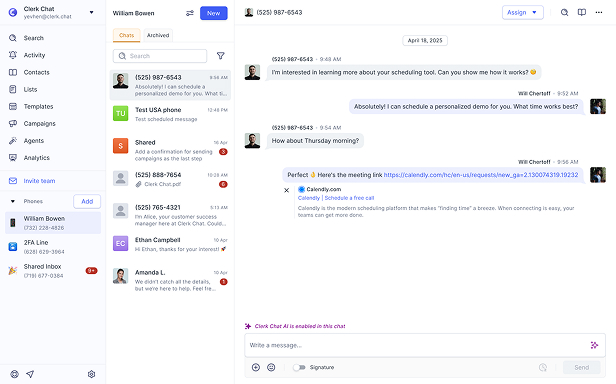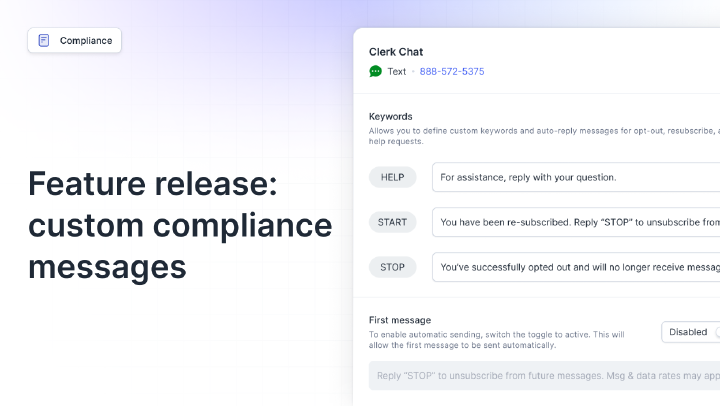Conversational Messaging
[kɒn.vəˈseɪ.ʃən.əl ˈmes.ɪ.dʒɪŋ]Conversational messaging transforms traditional one-way business texts into natural, two-way dialogues that build relationships and solve problems through real-time SMS exchanges. By treating text as a conversation rather than a broadcast channel, businesses achieve 80% customer satisfaction rates while reducing support costs by 40%.
Why Conversational Messaging Matters
The death of phone calls has been greatly exaggerated—but their transformation into text conversations is undeniable. Today’s customers spend 5 hours daily on mobile devices yet ignore 91% of phone calls from unknown numbers. This shift creates a communication crisis: businesses need customer dialogue, but traditional channels no longer connect effectively.
Conversational messaging solves this disconnect by meeting customers in their preferred communication channel. Unlike email’s 24-hour response expectations or phone calls’ immediate time demands, text conversations flow naturally throughout the day. A customer can start a product inquiry during their morning commute, continue it at lunch, and complete the purchase that evening—all within the same threaded conversation.
The business impact extends beyond convenience. Companies implementing conversational messaging through platforms like Clerk Chat report remarkable improvements: 67% of support issues resolved without phone calls, 40% higher customer retention rates, and 50% faster problem resolution. Perhaps most importantly, conversational messaging humanizes digital interactions. In an era of automated everything, the ability to have a real conversation via text becomes a competitive differentiator that builds lasting customer relationships.
How Conversational Messaging Works
Conversational messaging operates through coordinated systems that enable natural dialogue flow:
Conversation Initiation: Customers start conversations through multiple entry points - replying to appointment reminders, texting keywords, clicking “Text Us” buttons on websites, or responding to marketing messages.
Intelligent Routing: The messaging platform identifies conversation intent through keywords, previous interaction history, or customer selection. It then routes to the appropriate team member or department.
Context Preservation: Unlike phone calls that start fresh each time, conversational messaging maintains full context. Agents see complete conversation history, customer information, and relevant notes.
Natural Dialogue Flow: Agents respond using conversational language, asking clarifying questions and providing personalized solutions. Customers reply at their convenience without losing conversation context.
Multi-tasking Capability: Agents manage multiple conversations simultaneously through unified dashboards, dramatically increasing efficiency compared to one-at-a-time phone calls.
Seamless Handoffs: When expertise or shift changes require agent transitions, conversations transfer smoothly with full context, preventing customer frustration from repeating information.
Resolution Tracking: Each conversation includes outcome tracking, satisfaction measurement, and follow-up scheduling, creating continuous improvement opportunities through data analysis.
Best Practices with Conversational Messaging
Respond Quickly to Set Expectations - Acknowledge new conversations within 2 minutes, even if just to say “Hi Sarah, I’m reviewing your question and will have an answer shortly.” Quick acknowledgment prevents customer anxiety and multiple follow-ups.
Write Like You Talk - Use natural language, contractions, and appropriate casual tone. “I’d be happy to help with that!” works better than “I shall assist you with your inquiry.” Match your customer’s communication style.
Ask One Question at a Time - Avoid overwhelming customers with multiple questions in one message. Ask about order number first, wait for response, then ask about the specific issue. This creates natural conversation flow.
Use Names and Personal Details - Reference previous interactions, remember preferences, and use the customer’s name naturally throughout conversation. “I see you ordered the blue model last time, John. Would you like the same color?”
Provide Clear Next Steps - End each conversation with specific actions and timelines. “I’ve processed your refund. You’ll see it in 2-3 business days. Text back if you don’t see it by Thursday.”
Know When to Switch Channels - Recognize when text isn’t sufficient. For complex technical issues or emotional situations, offer a phone call: “This might be easier to explain by phone. Can I call you now, or would 3 PM work better?”
Enable Rich Media Sharing - Allow customers to send photos of products, receipts, or issues. Respond with images when helpful—maps for directions, product photos for clarification, or screenshots for instructions.
Real world examples
- Customer Service
Resolved 67% of inquiries without phone calls via SMS
Read more - Nonprofits
Increased donor retention 40% through personalized text conversations
Read more
Common misconceptions
Many successful conversational messaging programs use human agents who respond naturally to create authentic dialogues.
73% of customers want the option to have real conversations via text when dealing with complex issues.
Two-way messaging resolves issues 50% faster than phone calls by eliminating hold times and phone tag.
Related terms
In this article:
Ready to use your business number for text messaging?
Thousands of businesses are already experiencing the power of conversational messaging through SMS. Join us. Free trial and paid tiers available.
Get StartedFAQ
Have questions? We've got answers.
Find what you need quickly and clearly with our most frequently asked questions.
Conversational messaging transforms traditional one-way business texts into natural, two-way dialogues that mirror human conversation. Instead of sending broadcast messages that customers can't reply to, businesses engage in real-time text exchanges where customers ask questions, provide feedback, and complete transactions through familiar SMS conversations. This approach combines the convenience of texting with the personal touch of human interaction.
Start by choosing a platform like Clerk Chat that supports two-way messaging with features like conversation threading and team collaboration. Set up keyword triggers for common inquiries, train your team on text-based customer service best practices, and establish response time standards (ideally under 5 minutes during business hours). Create conversation templates for frequent scenarios while maintaining flexibility for natural dialogue. Most businesses see positive results within the first week.
Conversational messaging typically requires 40% less staffing than phone support since agents can handle 3-5 text conversations simultaneously versus one phone call. Initial setup costs include platform fees ($50-500/month) and staff training (8-16 hours). Ongoing costs involve per-message fees ($0.01-0.05) and agent time. However, the efficiency gains and higher customer satisfaction scores deliver ROI within 2-3 months for most businesses.
While chatbots provide automated responses based on programmed logic, conversational messaging emphasizes human-to-human interaction through text. Chatbots excel at handling simple, repetitive queries but often frustrate customers with complex needs. Conversational messaging allows natural language, context understanding, and emotional intelligence that builds relationships. Many businesses use hybrid approaches where AI assists human agents rather than replacing them.
Text conversations excel for appointment scheduling, order updates, customer support inquiries, payment reminders, feedback collection, and sales consultations. They work particularly well for situations requiring back-and-forth clarification, sharing of photos or documents, or when customers need time to consider responses. Avoid text for highly emotional situations, complex technical troubleshooting requiring screen sharing, or legally sensitive matters requiring detailed documentation.
Track metrics including average response time (target under 5 minutes), conversation resolution rate (aim for 70%+ first-contact resolution), customer satisfaction scores (typically 80%+ for good programs), conversation length (shorter indicates efficiency), and conversion rates for sales conversations. Also monitor agent productivity metrics like conversations handled per hour and customer retention rates. Compare these against your phone and email channels.




